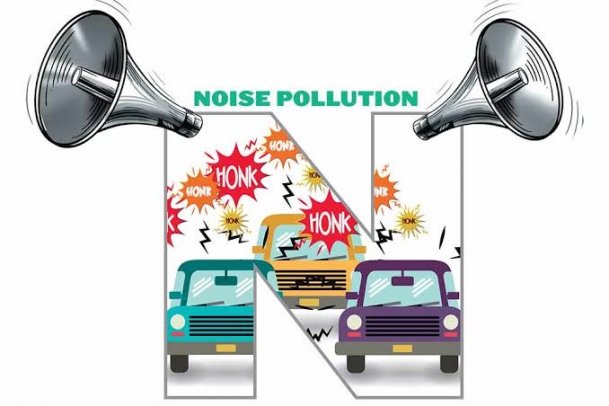Noise pollution

NOISE POLLUTION
Noise pollution may be a major problem in cities round the world. Noise is defined as unwanted sound. Environmental noise consists of all the unwanted sounds in our communities except that which originates within the workplace. Environmental sound pollution , a sort of pollution , may be a threat to health and well-being. It is more severe and widespread than ever before, and it'll still increase in magnitude and severity due to increase , urbanization, and therefore the associated growth in the use of increasingly powerful, varied, and highly mobile sources of noise. It will also still grow due to sustained growth in highway, rail, and traffic , which remain major sources of environmental noise. In factory workplace workers are exposed to high noise thanks to machinery in routine. The potential health effects of sound pollution are numerous, pervasive, persistent, medically and socially significant. Noise produces direct and cumulative adverse effects that impair health and that degrade residential, social and working environment with corresponding real (economic) and intangible (well-being) losses. Noise represents an important public health problem that can lead to hearing loss, sleep disruption, cardiovascular disease, social handicaps, reduced productivity, negative social behaviour, annoyance reactions, absenteeism and accidents. It can impair the ability to enjoy one's property and leisure time and increases the frequency of antisocial behaviour. Noise adversely affects general health and well-being within the same way as does chronic stress. It adversely affects future generations by degrading residential, social, and learning environments with corresponding economic losses. The aim of enlightened governmental controls should be to guard citizens from the adverse effects of airborne pollution, including those produced by noise. .
The WHO has documented seven categories of adverse health effects of sound pollution on humans. Much of the subsequent comes from the WHO Guideline on Community Noise and follows its format. The guideline provides an excellent, reasonably up-to-date, and comprehensive overview of noise-related issues, as do the other recent reviews on this subject.
HEARING IMPAIRMENT
Hearing impairment is typically defined as an increase in the threshold of hearing as clinically assessed by audiometry. Impaired hearing may come from the workplace, from the community and from a variety of other causes]. There is general agreement that exposure to sound levels but 70 dB doesn't produce hearing damage, no matter the duration of exposure.There is also general agreement that exposure for quite 8 hours to sound levels in more than 85 dB is potentially hazardous; to put this in context, 85 dB is roughly like the noise of heavy vehicular traffic on a busy road.With sound levels above 85 dB, damage is said to instantaneous sound pressure (measured in dB) and to time of exposure. The major explanation for deafness is occupational exposure, although other sources of noise, particularly recreational noise, may produce significant deficits. Studies suggest that children seem to be more vulnerable than adults to noise induced hearing disorder
Cardiovascular Disturbances
A growing body of evidence confirms that noise pollution has both temporary and permanent effects on humans (and other mammals) by way of the endocrine and autonomic nervous systems. It has been postulated that noise acts as a nonspecific biologic stressor eliciting reactions that prepare the body for a fight or flight response. For this reason, noise can trigger both endocrine and autonomic nervous system responses that affect the cardiovascular system and thus may be a risk factor for cardiovascular disease. These effects begin to be seen with long-term daily exposure to noise levels above 65 dB or with acute exposure to noise levels above 80 to 85 dB. Acute exposure to noise activates nervous and hormonal responses, resulting in temporary increases in vital sign , pulse , and vasoconstriction. Studies of people exposed to occupational or environmental noise show that exposure of sufficient intensity and duration increases pulse and peripheral resistance, increases vital sign , increases blood viscosity and levels of blood lipids, causes shifts in electrolytes, and increases levels of epinephrine, norepinephrine, and cortisol. Sudden unexpected noise evokes reflex responses as well.
Cardiovascular disturbances are independent of sleep disturbances; noise that doesn't interfere with the sleep of subjects should provoke autonomic responses and secretion of epinephrine, norepinephrine, and cortisol. These responses suggest that one can never completely get used to night-time noise .The studies that have been done on the effects of environmental noise have shown an association between noise exposure and subsequent cardiovascular disease. Even though the increased risk for noise-induced disorder could also be small, it assumes public health importance because both the amount of individuals in danger and therefore the noise to which they are exposed continue to increase . Children are at risk as well. Children who live in noisy environments have been shown to have elevated blood pressures and elevated levels of stress-induced hormones.
DISTURBANCES IN MENTAL HEALTH
Noise pollution isn't believed to be a explanation for mental disease , but it's assumed to accelerate and intensify the event of latent mental disorders. Noise pollution may cause or contribute to the subsequent adverse effects: anxiety, stress, nervousness, nausea, headache, emotional instability, argumentativeness, sexual impotence, changes in mood, increase in social conflicts, neurosis, hysteria, and psychosis.Population studies have suggested associations between noise and mental-health indicators, such as rating of well-being, symptom profiles, the use of psychoactive drugs and sleeping pills, and mental- hospital admission rates. Children, the elderly, and people with underlying depression could also be particularly susceptible to these effects because they'll lack adequate coping mechanisms. Children in noisy environments find the noise annoying and report a diminished quality of life.
Conclusions
The ultimate goal should be to spot ways to enhance the acoustic environment, but generally only rudimentary measures (dBA) are reported. These acoustic metrics may be overly simplistic for hospital environments .Additionally, a number of “mechanism” studies evaluating changes in the acoustic environment are needed in order to optimize the effectiveness of acoustic or behavioural alterations.
Written by – FAISAL MANSOOR
Amity university Lucknow
Co-author- MAYANK CHANDRA
Amity university Lucknow